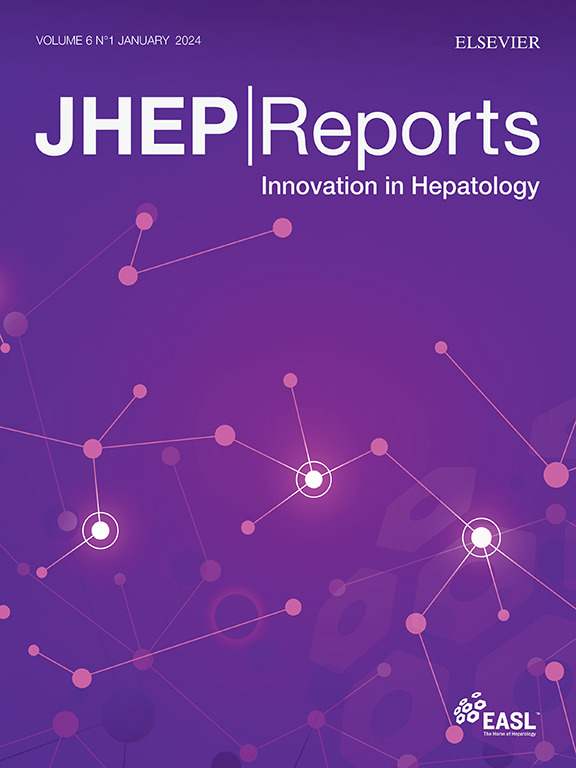成人急性肝功能衰竭的血清蛋白质组学提供了机制见解和有吸引力的预后生物标志物
IF 9.5
1区 医学
Q1 GASTROENTEROLOGY & HEPATOLOGY
引用次数: 0
摘要
背景,目的急性肝衰竭(ALF)被定义为无肝脏疾病史患者的快速发作凝血功能障碍和脑病。我们进行了非靶向和靶向血清蛋白质组学来描述成年ALF患者发生的过程,并确定潜在的生物标志物。方法从多中心美国急性肝衰竭研究组联盟的入院样本中随机选取319例ALF成年患者(~ 50%对乙酰氨基酚[APAP]相关病例)的血清,并将其细分为发现/验证队列。他们使用非靶向蛋白质组学、质谱和血清细胞因子谱分析进行分析,并与30名健康对照进行比较。主要临床结果为21天无移植生存期。单细胞RNAseq数据将生物标记物映射到起源细胞;功能富集分析提供了机制见解。将新预后评分与终末期肝病模型和ALFSG预后指数评分进行比较。结果在发现队列中,有117个蛋白在ALF患者与健康对照组之间存在差异。有167个蛋白与apap相关的ALF相关,其中大多数是肝细胞来源的。三种肝细胞蛋白(ALDOB、CAT和PIGR)可可靠且可重复地区分APAP与非APAP病例(auroc ~ 0.9)。在发现队列中,37种蛋白与21天的预后相关。与生存相关的关键过程是急性期反应和肝细胞核因子1α信号传导。在两个队列中,SERPINA1和LRG1是21天无移植生存的最佳个体鉴别因子。两种基于血液的蛋白质组学生物标志物模型优于终末期肝病模型和ALFSG预后指数,并在验证队列(AUROCs 0.83-0.86)中重现了21天无移植生存。结论:蛋白质组学和细胞因子分析发现了与APAP病因和21天预后相关的新的、可重复的生物标志物。这些生物标志物可以提高对ALF发病机制的预测和理解,但需要独立验证。影响和意义急性肝衰竭(ALF)是一种突发的、严重的疾病,死亡率高。迫切需要更敏感和特异性的预后评分,以促进ALF患者肝移植的决策。我们的蛋白质组学分析揭示了对乙酰氨基酚和非对乙酰氨基酚相关的ALF之间的显著差异。鉴定与21天无移植生存期相关的常规可测量的生物标志物和衍生新的预后评分可能有助于临床管理以及决定是否进行肝移植。需要进一步的研究来量化不那么丰富的蛋白质。虽然我们使用了两个队列,但我们的发现仍然需要独立和前瞻性的验证。本文章由计算机程序翻译,如有差异,请以英文原文为准。

Serum proteomics of adults with acute liver failure provides mechanistic insights and attractive prognostic biomarkers
Background & Aims
Acute liver failure (ALF) is defined as rapid onset coagulopathy and encephalopathy in patients without a prior history of liver disease. We performed untargeted and targeted serum proteomics to delineate processes occurring in adult patients with ALF and to identify potential biomarkers.
Methods
Sera of 319 adult patients with ALF (∼50% acetaminophen [APAP]-related cases) were randomly selected from admission samples of the multicenter USA Acute Liver Failure Study Group consortium and subdivided into discovery/validation cohorts. They were analyzed using untargeted proteomics with mass spectroscopy and a serum cytokine profiling and compared with 30 healthy controls. The primary clinical outcome was 21-day transplant-free survival. Single-cell RNAseq data mapped biomarkers to cells of origin; functional enrichment analysis provided mechanistic insights. Novel prognostic scores were compared with the model for end-stage liver disease and ALFSG prognostic index scores.
Results
In the discovery cohort, 117 proteins differed between patients with ALF and healthy controls. There were 167 proteins associated with APAP-related ALF, with the majority being hepatocyte-derived. Three hepatocellular proteins (ALDOB, CAT, and PIGR) robustly and reproducibly discriminated APAP from non-APAP cases (AUROCs ∼0.9). In the discovery cohort, 37 proteins were related to 21-day outcome. The key processes associated with survival were acute-phase response and hepatocyte nuclear factor 1α signaling. SERPINA1 and LRG1 were the best individual discriminators of 21-day transplant-free survival in both cohorts. Two models of blood-based proteomic biomarkers outperformed the model for end-stage liver disease and ALFSG prognostic index and were reproduced in the validation cohort (AUROCs 0.83-0.86) for 21-day transplant-free survival.
Conclusions
Proteomics and cytokine profiling identified new, reproducible biomarkers associated with APAP etiology and 21-day outcome. These biomarkers may improve prognostication and understanding of the etiopathogenesis of ALF but need to be independently validated.
Impact and implications
Acute liver failure (ALF) is a sudden, and severe condition associated with high fatality. More sensitive and specific prognostic scores are urgently needed to facilitate decision-making regarding liver transplantation in patients with ALF. Our proteomic analysis uncovered marked differences between acetaminophen and non-acetaminophen-related ALF. The identification of routinely measurable biomarkers that are associated with 21-day transplant-free survival and the derivation of novel prognostic scores may facilitate clinical management as well as decisions for/against liver transplantation. Further studies are needed to quantify less abundant proteins. Although we used two cohorts, our findings still need to be independently and prospectively validated.
求助全文
通过发布文献求助,成功后即可免费获取论文全文。
去求助
来源期刊

JHEP Reports
GASTROENTEROLOGY & HEPATOLOGY-
CiteScore
12.40
自引率
2.40%
发文量
161
审稿时长
36 days
期刊介绍:
JHEP Reports is an open access journal that is affiliated with the European Association for the Study of the Liver (EASL). It serves as a companion journal to the highly respected Journal of Hepatology.
The primary objective of JHEP Reports is to publish original papers and reviews that contribute to the advancement of knowledge in the field of liver diseases. The journal covers a wide range of topics, including basic, translational, and clinical research. It also focuses on global issues in hepatology, with particular emphasis on areas such as clinical trials, novel diagnostics, precision medicine and therapeutics, cancer research, cellular and molecular studies, artificial intelligence, microbiome research, epidemiology, and cutting-edge technologies.
In summary, JHEP Reports is dedicated to promoting scientific discoveries and innovations in liver diseases through the publication of high-quality research papers and reviews covering various aspects of hepatology.
 求助内容:
求助内容: 应助结果提醒方式:
应助结果提醒方式:


